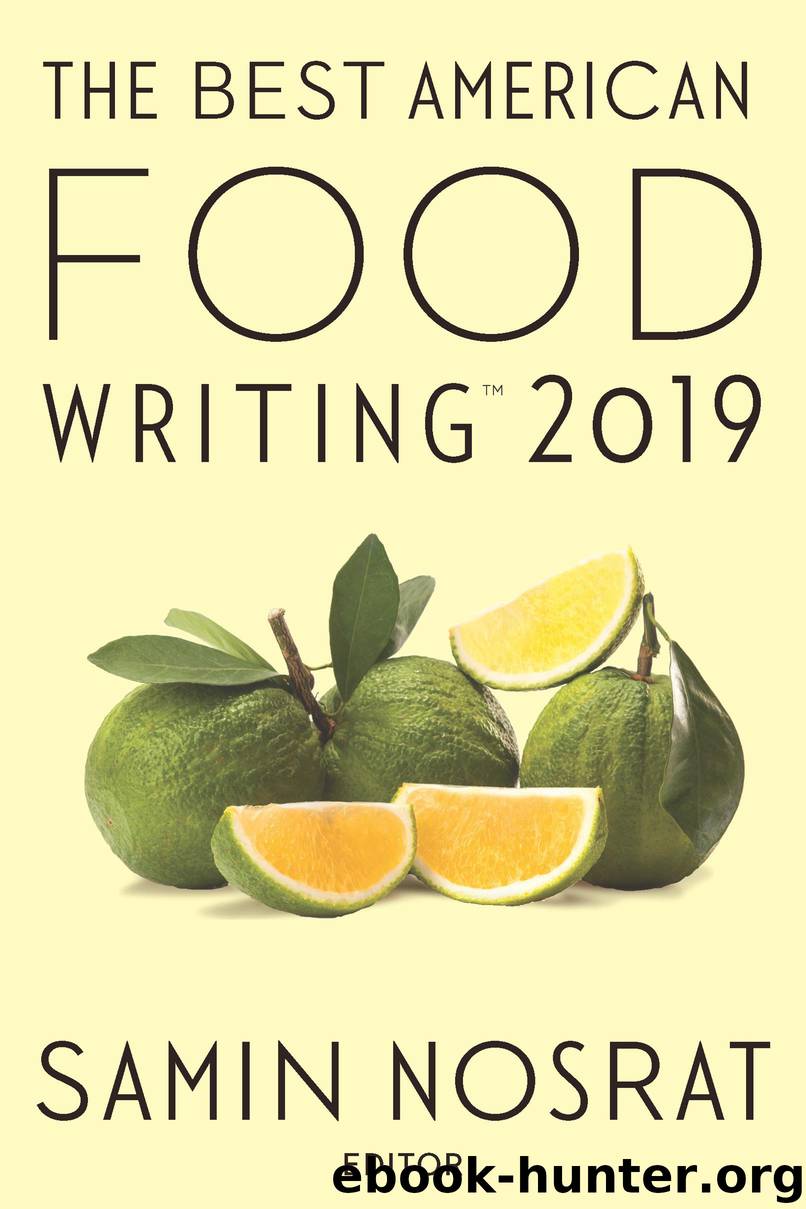The Best American Food Writing 2019 by Samin Nosrat

Author:Samin Nosrat
Language: eng
Format: epub
Publisher: HMH Books
HANNAH GOLDFIELD
Black History at Harlem Hops
from The New Yorker
THE OTHER NIGHT at Harlem Hops, a new beer bar and restaurant on Adam Clayton Powell Jr. Boulevard, a neighborhood old-timer peered at a fellow patron’s drink selection and gestured for the bartender’s attention. “Interestingly enough, this young lady has, like, four different beers,” he observed. The bartender laughed. “It’s called a flight,” he explained. “A flight?” replied the old-timer. “Like takeoff?” Harlem Hops is a thoroughly modern establishment, with a rotation of sixteen craft brews on tap, geeky tasting notes (“raw wheat, malted oat, milk sugar, lychee” for a sour IPA from the Hudson Valley), and a mostly young, hip crowd.
You’ll want to take a picture of the enormous, buttery Bavarian pretzel, flecked with salt crystals, which arrives swinging from the kind of metal stand you might use to hang bananas on your kitchen counter. You’ll want to return at least as many times as it takes to try each of the snappy-skinned bratwursts, from Jake’s Handcrafted, in Brooklyn, served on griddled pretzel buns. The one made with chicken—laced with sansho peppercorn and sweet soy sauce—and the one that repurposes intensely smoky, burnt-brisket ends are especially exciting.
The owners, Kevin Bradford, Kim Harris, and Stacey Lee, three beer lovers in their forties, were tired of having to leave the neighborhood to get the variety they craved. They wanted to highlight small local breweries, especially those run by brewers of color. They wanted to excavate history too. Did you know that some of the earliest evidence of beer-making, using warm-climate cereals like millet and sorghum, was found in Africa? That ancient Egyptians developed a malting process? That slaves in the American South brewed beer? Bradford, Harris, and Lee, all graduates of historically black colleges and universities, enlisted a historian named Tonya Hopkins, known as the Food Griot, to provide these reminders of the past, which are written in chalk on a pillar at the end of the bar. They also serve a whiskey, made in Tennessee, called Uncle Nearest; Nathan (Nearest) Green was a black master distiller believed to have taught Jack Daniel everything he knew. Where Jack Daniel’s is harsh, the bartender argued—“the opposite of that first gulp of water in the morning”—Uncle Nearest moves through your mouth “like a curl. It plays on your lips.”
The whiskey went down easy—citrus on the nose, spicy caramel and vanilla on the palate—and paired well with a crispy “Guma pie,” a tortilla wrapped like a sharp-cornered package around ground beef seasoned with habanero and African allspice, shipped up from a Virginia-based company started by a Ugandan refugee. The old-timer, who’d taken a phone call, sipped his own whiskey and shared his newfound trivia with whoever was on the other end of the line. “Uncle Nearest got ripped off by Jack Daniel,” he said, laughing heartily. “I’d have been looking for him.”
Download
This site does not store any files on its server. We only index and link to content provided by other sites. Please contact the content providers to delete copyright contents if any and email us, we'll remove relevant links or contents immediately.
| Culinary Biographies | Essays |
| Food Industry | History |
| Reference |
A Court of Wings and Ruin by Sarah J. Maas(7560)
The Sprouting Book by Ann Wigmore(3510)
Better Homes and Gardens New Cookbook by Better Homes & Gardens(3485)
The Death of the Heart by Elizabeth Bowen(3483)
BraveTart by Stella Parks(3366)
Salt, Fat, Acid, Heat: Mastering the Elements of Good Cooking by Nosrat Samin(3078)
Sauces by James Peterson(3016)
The Bread Bible by Rose Levy Beranbaum(2969)
Kitchen confidential by Anthony Bourdain(2969)
Classic by Mary Berry(2916)
Solo Food by Janneke Vreugdenhil(2897)
Ottolenghi - The Cookbook by Yotam Ottolenghi(2802)
Martha Stewart's Baking Handbook by Martha Stewart(2747)
Day by Elie Wiesel(2688)
Betty Crocker's Good and Easy Cook Book by Betty Crocker(2657)
My Pantry by Alice Waters(2511)
The Plant Paradox by Dr. Steven R. Gundry M.D(2511)
The Kitchen Counter Cooking School by Kathleen Flinn(2454)
Hot Sauce Nation by Denver Nicks(2423)
